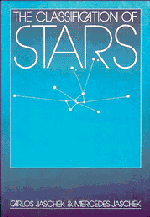7 - Introduction
Published online by Cambridge University Press: 04 April 2011
Summary
The second part of this book is devoted to the description of the different groups of stars which have been defined over the years. We shall start with the hottest stars and work toward the cooler ones, each chapter dealing with one type of object. The material is arranged broadly into ‘families’ (chapters), so that stars which are similar appear together.
Stars with peculiar spectra are dealt with in sections added to the relevant chapter. Since many groups are not limited to one spectral class, the place of a given group in the book is usually the one corresponding to the first appearance of the group. So, for example, Am stars are discussed in section 10.1 of the A-type stars, despite the fact that some Am stars are found among F-type objects.
As far as possible, each chapter has the following structure. First, we define each group, taking in as much history as we need, but without trying to write the whole history of the group. Then we describe the spectrum of the type of star, usually in the classical region, but, if information exists, also in the ultraviolet, infrared and radio regions. Rotation is also included here. Next we examine what photometry can tell us about the group; then we consider the absolute magnitude, whether any of the group are binaries and finally statistical properties like presence in clusters, distribution on the sky and the frequency of the stars of the group.
- Type
- Chapter
- Information
- The Classification of Stars , pp. 100 - 104Publisher: Cambridge University PressPrint publication year: 1987

